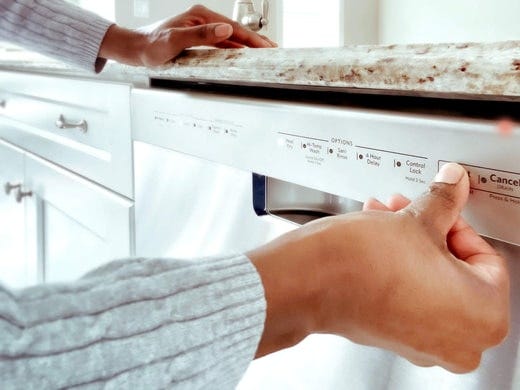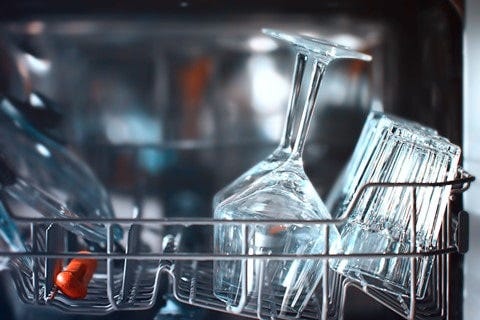
10 Common Dishwasher Mistakes to Avoid
Since the inception of dishwashers, there have been many things that could be improved about handling and cleaning these devices. Dishwashers can be a saviour, but they also require assistance from you.

Since the inception of dishwashers, there have been many things that could be improved about handling and cleaning these devices. Dishwashers can be a saviour, but they also require assistance from you. Here are the 10 common dishwasher mistakes to avoid in order to extend your dishwasher's lifespan.
1. Cleaning the dishwasher is not just an automated process
Two of the most important parts of any dishwasher that you need to keep clean at regular intervals are the high-pressure spray arms and the filter that traps food and other debris. Although some new and advanced dishwashers provide an auto-cleaning mechanism for filters, it is safe to clean them yourself to avoid a breeding ground for bacteria to grow.
2. Don’t overload your dishwasher
Resist the urge to overload your dishwasher, as doing so can impede efficient water flow and compromise cleaning quality. Adequate spacing between items is essential to enable proper distribution of water and detergent, ensuring every piece is thoroughly cleaned. Effective loading not only enhances washing performance but also safeguards your dishes and the dishwasher itself from potential harm.
3. Pre-rinsing to another level
While pre-rinsing dishes before loading the dishwasher might seem like a prudent move, it's worth noting that dishwashers actually function better with a bit of residual dirt. Experts suggest that detergents require a certain amount of debris to adhere to for optimal cleaning. The enzymes in modern dishwasher detergents work more effectively when they have food particles to break down.
This means that by leaving a small amount of grime on your dishes, you're providing the detergent with something to work on, resulting in cleaner and more efficient wash cycles. So, instead of meticulously pre-rinsing, allow your dishwasher to tackle the job it's designed for—cleaning dishes while making the most of its cleaning agents.
4. Cleaning with Wrong Wash Cycles
Selecting the incorrect cycle is a common mistake. Remember that various dishes call for specific cycles. To conserve energy, refrain from using intensive cycles for lightly soiled items. Optimal settings ensure thorough cleaning while being mindful of energy consumption. While some new devices have sensors that can detect soil levels automatically, it is recommended to check it yourself.
Delicate glassware and heavily soiled pots shouldn't share the same cycle. Many dishwashers offer pre-set programs like "Quick Wash" or "Eco Mode." Utilize these options based on your load.
5. Not using the right detergent for your pots and dishes
Optimal cleaning performance hinges on selecting the right dishwasher detergent. Dishwasher-specific detergents are formulated to dissolve effectively with minimal suds. Opting for regular dish soap can generate excessive suds, risking leaks and compromising cleaning efficiency. These suds can impede the dishwasher's function, leading to subpar outcomes.
Dishwasher detergents contain specialized enzymes that effectively tackle food residues and stains, ensuring pristine dishes. Moreover, using the correct detergent extends the dishwasher's lifespan by preventing buildup and blockages. To sustain your dishwasher's efficacy and achieve impeccable results, adhere to detergents tailored explicitly for dishwashers.
6. Setting the right temperature
Neglecting to consider the significance of the correct water temperature can hinder your dishwasher's performance. Specific detergents are designed to work best within particular temperature ranges. Ensuring your water heater is set to the recommended temperature for dishwashing, typically around 120°F (49°C), is vital. If the water temperature is too low, detergent might not dissolve adequately, leading to unsatisfactory cleaning results.
Conversely, extremely high temperatures can potentially damage dishes and glassware over time. Finding the right balance ensures optimal activation of detergents, effectively breaking down food residues and grease. By paying attention to this aspect, you can unlock your dishwasher's full cleaning potential while safeguarding the durability of your dishes.
7. Avoid shutting the door constantly
We're not suggesting you leave it open all the time; just do so when the dishwasher isn't in operation. The internal conditions tend to be damp, especially in warm South African weather, which can lead to mold growth if the door remains closed.
Allowing the appliance to air out between cycles provides it with an opportunity to breathe and prevents mold from forming.
8. Placing in items that don’t belong in the dishwasher
A prevalent error is including items not suitable for dishwashers, which can result in undesirable outcomes. Fragile materials like wood, cast iron, and delicate glassware often lack the resilience to endure the rigorous dishwasher environment. Wood may suffer warping, cracking, or finish deterioration from prolonged exposure to heat and detergent. Cast iron objects can succumb to rust and seasoning loss, while delicate glassware might incur chips or cracks due to intense pressure and heat.
9. Unpacking the wrong way
Another frequently made mistake that can be easily avoided for an improved cleaning experience involves the proper technique of unloading the dishwasher. The top rack typically holds cups and bowls, which could potentially retain water. When you unload the top rack before the bottom one, any residual water left in those items may spill onto the dishes in the bottom rack, leading to unsightly water stains.
To prevent this issue, it's advised to start unloading the bottom rack first. By adopting this approach, you prevent water from transferring onto your dishes, preserving their cleanliness and appearance. A simple adjustment like this contributes to a more seamless and effective dishwasher routine.
10. Not running the dishwasher when there are less utensils
Neglecting to run the dishwasher with fewer utensils is a common oversight that can be easily rectified for optimal efficiency. Modern dishwashers are designed with programs that cater to running half-empty loads. While it might appear counterintuitive, as it could seem wasteful to use more water for a smaller load, employing the preset programs for half loads can actually lead to water and effort savings. These specialized programs adjust water usage and cycle duration according to the load size. They ensure that the resources utilized are proportionate to the load, preventing excessive water consumption.
Consequently, even with fewer utensils, running the dishwasher can be more efficient than manual cleaning. Embracing this approach maximizes the dishwasher's effectiveness while minimizing resource wastage, aligning with both convenience and eco-consciousness.


